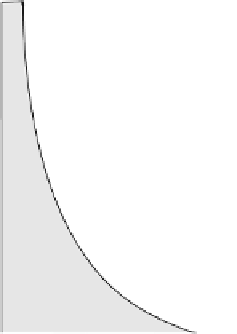Geoscience Reference
In-Depth Information
R = 0.2
R = 0.05
R = 0.2
R = 0.05
R = 0.2
R = 0.05
90
80
u = 0.6 m s
−
1
u = 0.02 m s
−
1
u = 0.1m s
−
1
70
60
1
2
3
Coriolis effect in
horizontal circulation:
50
40
1
= is insignificant
= becomes significant
30
2
20
3
= is significant
10
0
1
10
100
1000
Lagoon width, km
FIGURE 6.16
Range of significant-insignificant Coriolis effects as a function of latitude and
lagoon width for three fixed characteristic velocities.
where the latitude
10
−5
s
−1
and the charac-
teristic velocity is within the range of 0.05-0.10 m s
−1
, the radius of inertial cycle can
be estimated as
r
c
ϕ
is 55
°
, the Coriolis parameter
f
is 11.94
⋅
0.044-0.088. In this case, the Coriolis force
is significant in the whole lagoon since the average width is 9 km.
Strictly speaking, the Coriolis force is at work in any basin at any movement.
The period of the Coriolis cycle equals 2
≈
400-800 m, and
R
ϕ
≈
f
−1
, which yields values of 23 h 56 min,
14 h 37 min, and 12 h and 44 min for latitudes of 30
π
, respectively.
This means that any advective movement of equivalent or longer time scales will
be affected by the Coriolis force. Since the horizontal spatial scale in a lagoon is
fixed, the slower the movement is in the lagoon, the greater the influence of Coriolis
force on water dynamics and mixing processes. Although this may seem contrary
to the idea that Coriolis acceleration is proportional to speed, this can be seen in
Figure 6.16 and
Figure 6.17.
Assuming that the wind-induced water velocity in a lagoon is 0.1 m s
−1
,
Figure 6.16 shows that the Coriolis effect at a fixed latitude is insignificant when
a lagoon width
L
width
is less than 5 ·
r
c
or
R
ϕ
°
, 55
°
, and 70
°
>
0.2 starts to be significant (shaded
strip) when 5 ·
r
c
L
width
< 20 ·
r
c
, or , and dominates when
L
width
>
20 ·
r
c
, or . Similar arguments can be made for the same lagoon width at
different latitudes. For example, the Coriolis effect is important for all lagoons with
a width of 10 km only if they are located at latitudes greater than 45
<
0.05
<<
R
ϕ
0.
R
ϕ
<
005
.
. Furthermore,
considering a velocity of 0.02 m s
−1
as a lower limit of natural lagoon velocities
(as measured by most oceanographic instruments), Figure 6.16 indicates that the
circulation in any lagoon with a length scale less than
°
*
L
min
will never be affected







































Search WWH ::

Custom Search